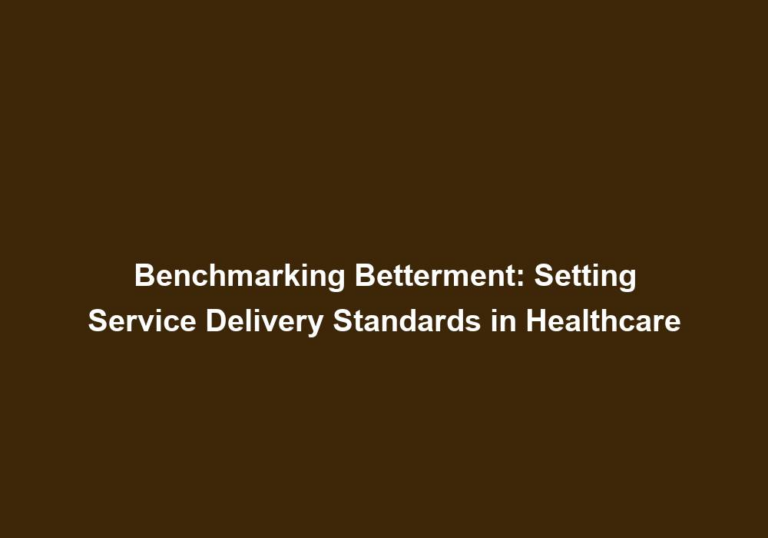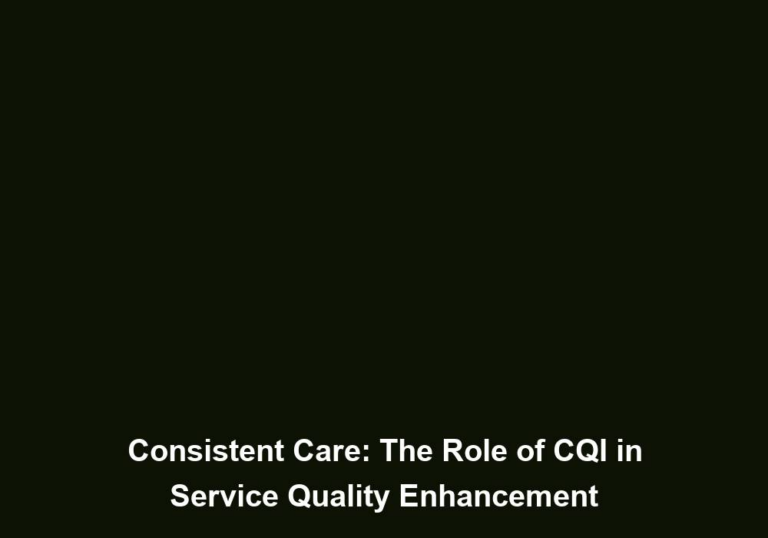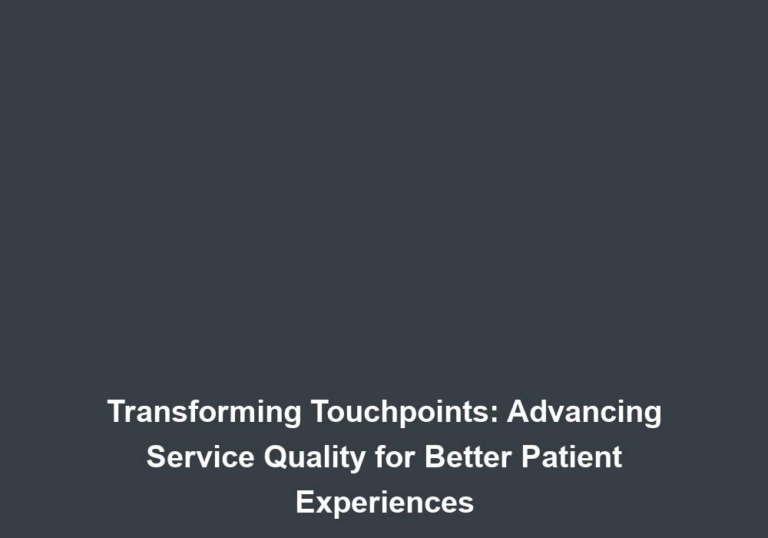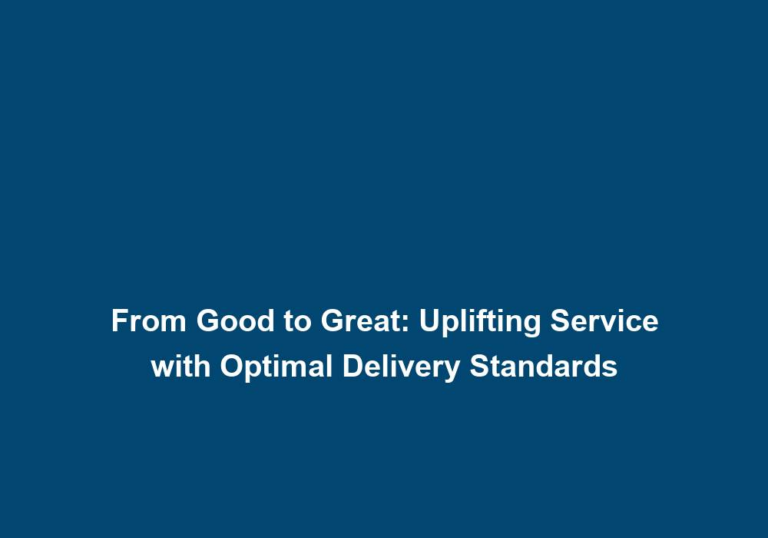Consistent Care: The Role of CQI in Service Quality Enhancement
In today’s highly competitive business landscape, providing high-quality services is crucial for maintaining a competitive edge. One effective approach to achieving service quality enhancement is through the implementation of Continuous Quality Improvement (CQI) practices. CQI plays a vital role in ensuring consistent care and enhancing the overall service delivery within an organization.
Understanding CQI
Continuous Quality Improvement (CQI) is a systematic approach that focuses on identifying and implementing ongoing improvements to enhance processes, services, and outcomes. Its main objective is to ensure that organizations consistently meet or exceed the expectations of their customers. CQI involves analyzing data, identifying areas for improvement, implementing changes, and evaluating the effectiveness of those changes.
CQI is a proactive approach that enables organizations to continuously monitor and evaluate their service quality, identifying areas that need improvement and making necessary adjustments. By utilizing data-driven decision making, organizations can make informed choices based on evidence rather than assumptions or guesswork. This allows them to allocate resources effectively and efficiently, leading to enhanced service quality.
The Importance of Consistent Care
Consistency is a key component of providing high-quality services. When customers can rely on consistent care, they develop trust and confidence in an organization, which leads to customer loyalty and satisfaction. Consistent care means delivering services that are reliable, predictable, and free from variations or inconsistencies.
Consistent care is essential for building strong relationships with customers. When customers receive consistent care, they know what to expect from an organization and can rely on the quality of service they will receive. This builds trust and fosters long-term customer loyalty. Moreover, consistent care also helps organizations in managing their reputation, as positive word-of-mouth spreads when customers consistently receive high-quality service.
How CQI Enhances Service Quality
CQI initiatives can significantly improve service quality by addressing areas that need improvement, streamlining processes, and minimizing errors or defects. Here are some ways in which CQI enhances service quality:
1. Data-driven Decision Making
CQI relies on data analysis to identify areas that require improvement. By collecting and analyzing data related to service delivery, organizations can make informed decisions based on evidence, rather than relying on assumptions or guesswork. This data-driven approach ensures that resources are allocated efficiently and effectively to enhance service quality.
Data-driven decision making is crucial in identifying trends, patterns, and areas for improvement. By analyzing customer feedback, organizations can gain insights into the specific aspects of their services that need enhancement. This allows them to prioritize improvement efforts and allocate resources where they will have the most significant impact. By continuously monitoring and analyzing data, organizations can stay ahead of customer expectations and continuously improve their service quality.
2. Identifying Root Causes
CQI allows organizations to identify and address the root causes of issues or problems that impact service quality. Rather than solely focusing on treating symptoms, CQI helps organizations dig deeper to find the underlying causes and implement long-lasting solutions. By addressing root causes, organizations can prevent recurring issues and ensure consistent care.
Identifying root causes is crucial in eliminating issues that hinder service quality. By conducting root cause analysis, organizations can uncover the underlying factors that contribute to service deficiencies. This enables them to implement targeted solutions that address the core issues, leading to more sustainable improvements in service quality. By focusing on root causes, organizations can eliminate issues at their source, preventing them from negatively impacting service quality in the future.
3. Standardizing Processes
Consistency can be achieved through the standardization of processes. CQI helps organizations identify best practices, develop standardized procedures, and ensure that these processes are consistently followed. By standardizing processes, organizations can minimize variations and deviations, leading to more reliable and consistent service delivery.
Standardizing processes is essential in ensuring that service quality remains consistent across different teams, departments, or locations within an organization. By establishing clear guidelines and procedures, organizations can eliminate ambiguity and ensure that all employees follow the same standards. This reduces the likelihood of errors, improves efficiency, and enhances the overall quality of service delivery.
4. Continuous Training and Development
CQI emphasizes the importance of continuous training and development for employees. By providing ongoing training and education, organizations can ensure that their staff remains up-to-date with the latest industry practices and developments. Well-trained employees are better equipped to provide consistent care and deliver high-quality services to customers.
Continuous training and development help employees stay current with evolving customer expectations and industry trends. It equips them with the necessary knowledge and skills to provide exceptional service consistently. By investing in employee development, organizations create a culture of continuous improvement, where employees are motivated to enhance their skills and contribute to service quality enhancement.
5. Feedback and Communication
CQI encourages open and effective communication channels between stakeholders, including customers, employees, and management. By actively seeking feedback and input from all parties involved, organizations can identify areas for improvement and address customer concerns. Effective communication ensures that organizations stay aligned with customer expectations, leading to enhanced service quality.
Feedback and communication are crucial in understanding customer needs and expectations. By actively seeking feedback, organizations can gain valuable insights into areas where their services can be improved. This feedback can help them prioritize improvement efforts and make necessary adjustments to meet customer expectations. Additionally, effective communication channels facilitate the resolution of customer issues, ensuring that their concerns are addressed promptly and effectively.
6. Monitoring and Evaluation
CQI involves continuous monitoring and evaluation of processes and outcomes. By establishing performance indicators and regularly measuring progress, organizations can track the effectiveness of their improvement efforts. Monitoring and evaluation allow organizations to identify areas that require further attention and make necessary adjustments to enhance service quality.
Monitoring and evaluation provide organizations with valuable feedback on the effectiveness of their improvement initiatives. By tracking performance indicators, organizations can assess whether their efforts are yielding the desired results. This allows them to identify areas that require additional attention or modification, ensuring continuous enhancement of service quality. Regular evaluation also enables organizations to benchmark their performance against industry standards, identifying opportunities for further improvement.
Conclusion
In conclusion, CQI plays a critical role in service quality enhancement by promoting consistent care and addressing areas for improvement. Through data-driven decision making, identification of root causes, standardization of processes, continuous training and development, feedback and communication, and monitoring and evaluation, organizations can achieve higher levels of service quality. By implementing CQI practices, organizations can not only enhance customer satisfaction but also gain a competitive advantage in today’s highly competitive market.







